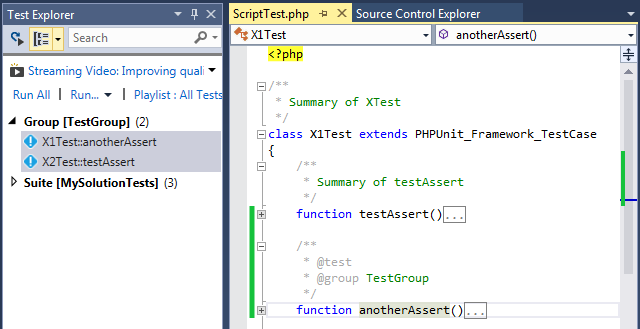Writing Test Case
A test case is a PHP class containing test methods. See phpunit.de/manual for more information about PHPUnit tests.
Test Explorer (in the menu Test / Test Explorer) lists all the available test suites by looking in phpunit.xml and phpunit.xml.dist configuration files in opened projects.
Note:
phpunit.xmlnorphpunit.xml.distfiles invendor/subfolder are ignored.
By default, the test file name must be placed within tests subdirectory, its name suffixed with Test.php, and the contained test class name suffixed with Test, extending the PHPUnit framework TestCase class. All the test methods should be either prefixed with test (lowercased) or have a PHPDoc tag @test.
The Test Explorer has a delay few seconds delay (3 seconds) before listing the updated test cases. It should show the following:

Note: script files have to be saved to reflect changes in the Test Explorer window.
Default Test Case
The following is a default test case class with a single test case function. Usually saved under the tests/exampletest.php file:
<?php
class ExampleTest extends \PHPUnit\Framework\TestCase
{
public function testFunction() {
$this->assertEquals(2, 1 + 1);
}
}Default phpunit.xml
A phpunit.xml file is required for the tests to be discovered. You can create a default phpunit.xml in the root of the project in the context menu under the project Add / New Item, choose category PHP, and the item template PHP Unit Configuration.

To create the file manually, create an empty file named phpunit.xml with the following default content:
<phpunit
xmlns:xsi="http://www.w3.org/2001/XMLSchema-instance"
xsi:noNamespaceSchemaLocation="https://schema.phpunit.de/6.3/phpunit.xsd"
backupGlobals="true"
backupStaticAttributes="false">
<testsuites>
<testsuite name="My Test Suite">
<directory>tests</directory>
</testsuite>
</testsuites>
</phpunit>The default configuration file defines a single test suite "My Test Suite", which includes all the *Test.php files within tests directory.